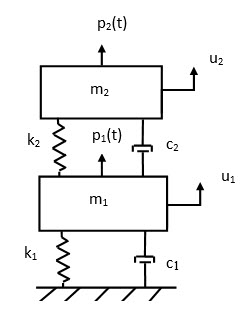Wire rope damping depends on:
1. Material
2. Diameter
3. Length
4. Number of strands
5. Number of turns per length
6. Initial tension or preload
7. Displacement amplitude
The damping can be very nonlinear, particularly depending on displacement amplitude.
The flexing of wire rope involves both coulombic and viscous damping. At very low vibration levels, the wire strands stick together and little sliding occurs. The damping is low and the behavior is viscous.
With higher displacements, coulomb damping predominates as the wires break free and start to slide against each other, absorbing large amounts of energy.
At large displacements the bending and stretching of the wire strands overshadows the sliding friction and viscous behavior again starts to show.
* * *
Here are some viscous damping values for straight cables.
Longitudinal Vibration for 10 mm (0.39 inch) diameter:
Damping = 0.7% to 2.0% (ref 1)
Transverse Vibration for 3/8 inch diameter:
Damping = 0.3% to 0.5% (ref 2)
* * *
For the case of wire rope used in helical isolators, the damping can vary from 5% to 22% (ref 3).
* * *
Wire Rope Isolation of a Camera Video
* * *
References
1. Feyrer, Wire Ropes: Tension, Endurance, Reliability
2. Vanderveldt, Chung and Reader, “Some Dynamic Properties of Axially Loaded Wire,” Experimental Mechanics, 1973.
3. http://www.enidine.com/Industrial/WireFAQmain/#14
* * *
See also:
http://sem-proceedings.com/24i/sem.org-IMAC-XXIV-Conf-s02p04-Modal-Damping-Estimates-from-Static-Load-deflection-Curves.pdf
Initial investigations into the damping characteristics of wire rope vibration isolators
* * *
– Tom Irvine








